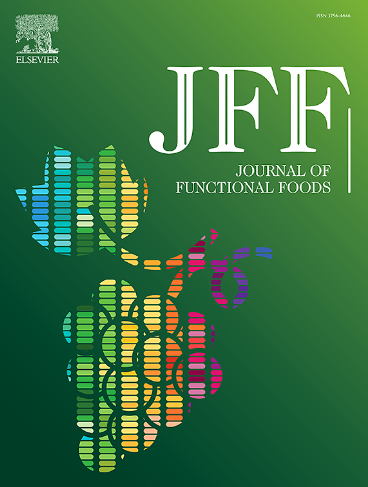Inonotus obliquus alleviates proteinuria of MRL/lpr mice by inhibiting ROS-NLRP3-mediated podocyte pyroptosis via facilitating Nrf2 translocation
IF 3.8
2区 农林科学
Q2 FOOD SCIENCE & TECHNOLOGY
引用次数: 0
Abstract
Proteinuria is a main feature of lupus nephritis (LN) in which NLRP3-mediated podocyte pyroptosis further exacerbates proteinuria. Our previous study confirmed the proteinuria-lowering, podocyte-protecting and anti-inflammatory effects of Inonotus obliquus (chaga) in diabetic kidney disease rats. Our in vivo and in vitro studies were conducted in female MRL/lpr mice and human glomerular podocyte cell line treated with IgG from LN patients' serum. Proteinuria changes were detected by urine protein test kit, C3 and ds-DNA by ELISA, renal histopathology and podocyte morphology were studied also. Western blot and RT-PCR were carried out to detect protein and mRNA levels of WT-1, Nephrin, NLRP3, GSDMD-N, Caspase-1 and IL-1β. ROS in podocytes was detected by fluorescent probes and MDA, LDH levels were measured by ELISA, and Nrf2 translocation was detected by immunofluorescence. In vivo study, chaga significantly decreased proteinuria, improved podocyte morphology and kidney pathological changes, meanwhile increased WT-1 and Nephrin expressions and suppressed NLRP3, GSDMD-N, Caspase-1 and IL-1β expressions when compared to the LN model. In vitro study, similar to Nrf2 activator, chaga facilitated Nrf2 translocate from cytosol into nucleus, suppressed ROS, MDA and LDH generation, then mitigated podocyte pyroptosis. The results indicated that the proteinuria-reducing effect of chaga on LN mice may be related to its promotion of Nrf2 translocation, thereby inhibiting NLRP3/Caspase-1/GSDMD-N-mediated podocyte pyroptosis.

斜腹肌通过促进Nrf2易位,抑制ros - nlrp3介导的足细胞焦亡,从而减轻MRL/lpr小鼠的蛋白尿
蛋白尿是狼疮性肾炎(LN)的主要特征,nlrp3介导的足细胞焦亡进一步加剧了蛋白尿。我们在前期研究中证实了斜桦对糖尿病肾病大鼠的降蛋白尿、保护足细胞和抗炎作用。我们的体内和体外研究是用LN患者血清IgG处理的雌性MRL/lpr小鼠和人肾小球足细胞系进行的。尿蛋白检测试剂盒检测尿蛋白变化,ELISA检测C3和ds-DNA,并观察肾脏组织病理学和足细胞形态学。Western blot和RT-PCR检测WT-1、Nephrin、NLRP3、GSDMD-N、Caspase-1和IL-1β的蛋白和mRNA水平。荧光探针检测足细胞ROS, ELISA检测MDA、LDH水平,免疫荧光检测Nrf2易位。在体内研究中,与LN模型相比,chaga显著降低了蛋白尿,改善了足细胞形态和肾脏病理改变,同时增加了WT-1和Nephrin的表达,抑制了NLRP3、GSDMD-N、Caspase-1和IL-1β的表达。体外研究发现,与Nrf2激活剂类似,chaga促进Nrf2从细胞质转运到细胞核,抑制ROS、MDA和LDH的产生,减轻足细胞焦亡。结果提示,chaga对LN小鼠的减尿作用可能与其促进Nrf2易位,从而抑制NLRP3/Caspase-1/ gsdmd - n介导的足细胞焦亡有关。
本文章由计算机程序翻译,如有差异,请以英文原文为准。
求助全文
约1分钟内获得全文
求助全文
来源期刊

Journal of Functional Foods
FOOD SCIENCE & TECHNOLOGY-
CiteScore
9.60
自引率
1.80%
发文量
428
审稿时长
76 days
期刊介绍:
Journal of Functional Foods continues with the same aims and scope, editorial team, submission system and rigorous peer review. We give authors the possibility to publish their top-quality papers in a well-established leading journal in the food and nutrition fields. The Journal will keep its rigorous criteria to screen high impact research addressing relevant scientific topics and performed by sound methodologies.
The Journal of Functional Foods aims to bring together the results of fundamental and applied research into healthy foods and biologically active food ingredients.
The Journal is centered in the specific area at the boundaries among food technology, nutrition and health welcoming papers having a good interdisciplinary approach. The Journal will cover the fields of plant bioactives; dietary fibre, probiotics; functional lipids; bioactive peptides; vitamins, minerals and botanicals and other dietary supplements. Nutritional and technological aspects related to the development of functional foods and beverages are of core interest to the journal. Experimental works dealing with food digestion, bioavailability of food bioactives and on the mechanisms by which foods and their components are able to modulate physiological parameters connected with disease prevention are of particular interest as well as those dealing with personalized nutrition and nutritional needs in pathological subjects.
 求助内容:
求助内容: 应助结果提醒方式:
应助结果提醒方式:


